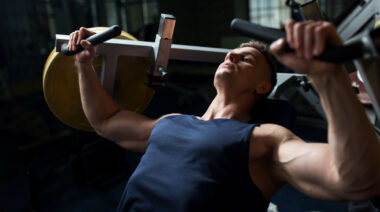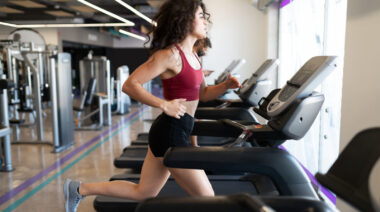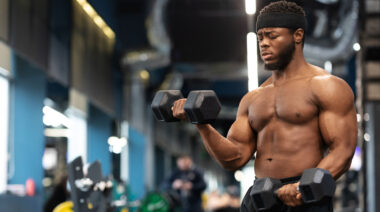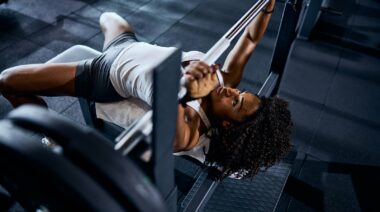Focusing on movement efficiency should be a primary aim of any well-constructed strength and conditioning program. Moving well requires a combination of mobility (flexibility and range of motion within the joints) and stability (motor control and postural musculature). On a continuum, achieving optimal fitness and athleticism looks like this:
While it can be a battle of the wills between common sense and ego, backing off the load to focus on the quality of your movement patterns is your best bet for long-term progress and optimal performance.
In this article, we’re going to look at improving movement quality when training the lower body.
Fix Your Broken Leg Movement
The lower extremities work in conjunction with the core to provide strength and power to the entire body. Any deficits in mobility or stability throughout the lower body’s kinetic chain can lead to injury, dysfunction, and a decrease in performance. By addressing alignment, asymmetries, mobility, stability, and dynamic motor control, you can reduce the risk of injury and maximize your training.
Mobility
Limited range of motion compromises the most basic of movement patterns, as tightness affects the ability to engage the right muscles in the right sequence.
Lower Body Mobility Issues
In the lower body, the most common mobility issues include ankles, calves, adductors and hip flexors. Tight hip flexors inhibit the ability of the glutes to engage. Furthermore, if we follow the joint-by-joint approach proposed by Gray Cook, a lack of hip mobility will force the joints above and below—the lumbar spine and the knees—to make up the difference.
Lower Body Mobility Solutions
Below is an example of a simple yet comprehensive mobility sequence that I use as part of a dynamic warmup before training the lower body. I perform 10 repetitions in total, alternating legs.
- Maintain the alignment of the hips, knees and 2nd/3rd toes throughout.
- Keep the heels on the ground to address the mobility of the ankle and Achilles.
- Use your elbows to drive the knees out in the lateral portion of the sequence.
- Use your breath to increase your range of motion on each repetition.
Asymmetry
While excessive tightness is detrimental to efficient movement, functional asymmetries (muscular imbalances, movement impairments) between the right and left sides of the body are a much higher risk factor for injury.
Think of your body as a race car. If the wheels are out of alignment, it will tear up the ball joints and tires. Make the car go faster and for longer, and the destruction will be far more widespread. If you sprain your left ankle, several “compensations” may occur: You will put more pressure on your right foot. Your left hip will become weaker. Your right hip will become stiffer because it’s overworked. If you then perform double leg movements with either volume or load, the compensation will be exacerbated, poor movement patterns reinforced and pain or injury will be the end result.
Lower Body Asymmetry Issues
The two most common structural asymmetry issues I see on a regular basis are:
- Single-leg, right versus left imbalance: Humans are unilaterally dominant, so if you have a weakness on one side, you will compensate on the other side setting yourself up for injury.
- Same-side lateral versus medial imbalance: A high proportion of knee injuries are caused by an imbalance where the outside of the leg (the IT band, TFL and Vastus Lateralis) is too tight, and the inside of the leg (the VMO or Vastus Medialis) is too weak. This causes incorrect tracking of the knee, leading to friction, inflammation and pain.
Lower Body Asymmetry Solutions
Single Leg Right-Left Imbalance:
Including single leg movements in your program allows you to correct left-right strength and size imbalances, improve general balance and proprioception, allows you to train around injuries, and has a huge carryover into athletic movements. I suggest including a wide array of single leg variations in the frontal (side to side movements), sagittal (movements forward and back), and rotational planes, including lunges, single leg off-box squats, step-ups, and single leg deadlifts.
I often use a 5 x 5 single-leg, off-box squat protocol as part of an extended dynamic warmup preceding lower body training, as it addresses mobility through the ankle and Achilles, the alignment of the entire lower limb from the hip through to the knee through to the 2nd/3rd toe, and glute stabilization of the supporting leg.
- The heel of the supporting leg stays on the box, as this is where the mobility of the ankle and Achilles is required.
- Maintain alignment of the hips, knees and 2nd/3rd toes throughout.
- Keep the pelvis level.
- Stay as upright as possible. I find it helps to have the arms out in front to act as a counterbalance.
- Use your own range of motion limitations to dictate the depth. Don’t compromise the movement to try and touch the ground.
- Keep the movement slow, smooth and controlled.
Lateral Versus Medial Imbalance
At the very minimum, I suggest regular foam rolling for the outside of the leg (primarily the ITB and TFL) for myofascial release, followed by targeted VMO isolation exercises to address the knee stabilization. Charles Poliquin introduced me to VMO step ups (with heel elevated), but even simple wall sits squeezing a foam roller between the inner thighs can be effective. I would schedule in 1-2 sets of 13-15 repetitions before my lower body training to make sure the muscle is switched on.
- Maintain the weight in the supporting heel. The higher the elevation of the heel (the greater the angle), the harder the exercise is.
- Maintain the alignment of the hip, knee, 2nd/3rd toe throughout.
- Draw the kneecap up at the top of the movement to actively engage the VMO.
Tip: When performing single leg sets, start with the weaker leg. If and when failure occurs, repeat the exercise for the same amount of reps on the other side. If it’s a mobility issue, you can skew the ratio of the stretching on a 2:1 or 3:1 basis favoring the tighter side.
Stability and Motor Control
Stability refers to the ability of the kinetic chain (i.e., nervous, skeletal, and muscular systems) to create integrity of a joint during movement. This is a combination of muscular timing, control, and sequence. For the most part, stability is reflex dependent. Motor control should be synonymous with stability.
Lower Body Stability and Motor Control Issues
The most common stability issue I see in regards to the lower body is in relation to the knee. If the knee collapses inwards, it is often associated with weakness of the hip abductors—most notably the gluteus medius and minimus.
Lower Body Stability and Motor Control Solutions
Bodyweight or low-load glute activation drills have always been practiced in a physical therapy environment. Recently, they have also become popular in a strength and conditioning setting. Isolated glute activation drills are a staple in my lower body dynamic warm-ups. My two favorite glute activation drills are the resistance band lateral monster walk, and the single-leg glute bridge. I perform them after the hip mobility sequence, and before my main workout.
- Keeping the feet hip distance apart, and the feet facing forwards. A common mistake is to allow the feet to turn out to move.
- Keeping the body upright. A common mistake is to lean to one side to compensate for the movement.
- Keeping the hips, knees, 2nd/3rd toes in alignment. A common mistake is to allow the feet and knees to collapse inwards. During set up, think about “screwing the feet into the ground” to help engage the glutes from the beginning.
- Keep the hips, knees, 2nd/3rd toes aligned throughout. If your knee has a tendency to fall out, it can indicate a tightness of the ITB and TFL.
- Keep the knee hugged in to the ribcage, to alleviate the involvement of the lower back in extending the hips. This ensures that the glutes are isolated.
- Weight is always on the heels. Heels = posterior chain.
Efficiency Is Power
If you can’t move efficiently, you can’t move effectively, and you will struggle to make any gains in your lower body training. In addition, the way in which the contralateral muscular slings of the body are organized, an injury in one area of the body may be the cause of or response to an injury, weakness, or imbalance in an opposite or seemingly unrelated portion of the body. Your gumby right hip has a cause and effect relationship with your left shoulder; the classic chicken-and-egg scenario.
Ultimately, mobility is the foundation upon which everything else—motor control, stability, strength, and power—is based. When you’re mobile enough, you can then work on motor control to be able to respond to your environment. Improving your stability will then ensure you respond more effectively. Only then can you add load to build strength, then build on that strength with speed. Never sacrifice your form for load, volume, or speed. It’s not practice that makes perfect. It’s perfect practice that makes perfect.
You can’t just do this stuff once in a while:






